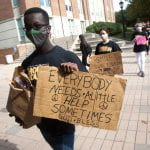How One Person’s Viewpoint Can Topple a Whole Organization

By Kayla Griffis
B.A. Advertising, Southern Methodist University ’20
M.A. Advertising, Southern Methodist University ’21
A few weeks ago the Dallas advertising industry was shaken to its core. A renowned agency has lost multiple clients in the span of a few days due to a comment made by its founder and owner. If you live in the DFW area or are a part of the advertising industry at large, you will have heard about this controversial statement made by Stan Richards and the severe fallout for The Richards Group. For those who do not know the situation and its impact, here is a quick rundown of what occurred. According to AdWeek, the 88-year-old — during an internal creative review for a campaign for Motel 6 — stated that he felt the concept to promote Black artists’ work was “too Black” for “white supremacist constituents.” This comment somehow made it to the media and Motel 6 immediately dropped The Richards Group as one of their agencies. And within the span of three days, they had lost longtime clients Home Depot, Keurig Dr Pepper, and H.E.B., and new prospective business at Cracker Barrel. The chance of recovery for this agency is in question and Stan Richards has now stated he is stepping down from all operations at the company.
A few days later, Richards seemed to double down on his controversial comments in an interview with Texas Monthly where he stated that he was only “trying to protect the client’s business” and said that the campaign would “run off…their guests.” He declared that the idea that was posed “should have been more multicultural” and that instead “It was very Black.” Richards expressed surprise when he had heard his words had garnered so much backlash and stated that “…instead of using…those three words, I could have said something that was more clouded in its meaning. And it would have saved an awful lot of trouble.” In addition, when he was asked about his white supremacist comment, he further explained that the client didn’t need to lose any of its current business, “even if it was white supremacists who chose not to do business with them.”
Richards outlined the current objectives for The Richards Group and how they plan to generate more awareness around the “potential to create [such] a problem” and said he stands by the fact that his comment was not racist and that he has “never been a racist anytime in [his] life.” He then finishes the interview by stating he will focus on helping students at the Stan Richards School at UT. Richards has also issued a video apologizing to the faculty, alumni, and the students of the school, stating it was “the biggest mistake of [his] life,” and an accompanying note from the director and dean of the Stan Richards School stated that his “racially intolerant and bigoted remarks” were not consistent with the school’s core values and that they will remain committed to “sustaining a culture of diversity, equity, and inclusion.”
Now let’s be honest. What Richards said was racist. Period. No matter his intentions, stating that he wanted to cater to white supremacist consumers and suppressing Black representation is uncalled for and quite frankly very disturbing. So the consequences that follow should be no different. During the peak of protests against police brutality and the demand for justice after the murders of Breonna Taylor and George Floyd, many companies called for the support and uplifting of Black voices and hired many artists to help create work. However, that “trend” didn’t last long, because soon after the initial news coverage of the protests started to die down, companies went back to the content they were creating before and the advocacy for Black people seemed to wane. This phenomenon was compounded by the insensitive email that was sent to a Black mural artist from Microsoft requesting that she create an art piece while the Black Lives Matter movement was still “relevant.”
Even though Stan Richards made these racist comments, which demonstrated how one remark can irrevocably ruin your reputation, the situation also demonstrates that the ramifications affect more than just him. Employees of  The Richards Group who didn’t express the same racist sentiments now are facing a future of uncertainty as well as unintended backlash for something they didn’t do. They have to scramble to figure out what the next best step is and balance the idea of jumping off a sinking ship or potentially going down with the captain. Now for some people, these developments may prove profitable since the newly available clients will be looking for another agency to work with and more jobs will be created in those businesses if they win. However, it still doesn’t negate the fact that livelihoods will be lost during a pandemic when the last thing anyone wants is an uptick in unemployment filings. Nevertheless, Stan Richards’ comment managed to severely damage a legacy he spent decades creating and possibly cost hundreds of people their jobs.
The Richards Group who didn’t express the same racist sentiments now are facing a future of uncertainty as well as unintended backlash for something they didn’t do. They have to scramble to figure out what the next best step is and balance the idea of jumping off a sinking ship or potentially going down with the captain. Now for some people, these developments may prove profitable since the newly available clients will be looking for another agency to work with and more jobs will be created in those businesses if they win. However, it still doesn’t negate the fact that livelihoods will be lost during a pandemic when the last thing anyone wants is an uptick in unemployment filings. Nevertheless, Stan Richards’ comment managed to severely damage a legacy he spent decades creating and possibly cost hundreds of people their jobs.
There is no shortage of examples for why diversity, equity and inclusion are vital to the growth and success of corporate America and society as a whole and this is just another one added to a never-ending list. Hopefully other companies who may have been remiss will realize that Black peoples’ lives aren’t a trend or something to commodify and do with as they please. This is real life and with our more socially conscious generations speaking out on the travesties and inhuman treatment that have been occurring for centuries, businesses that don’t get on board risk being decimated. So here’s a word of advice. Be a proponent of positive social change for the good of humanity and create work that pushes for a better world for everyone. And if that is too difficult, just not being a downright awful person could also help. And if that is still too much, at least realize that you will no longer make money if you alienate consumers and continue to uphold the discriminatory racist ideals that have plagued the minorities of America since its inception.
 Dr. Frasso, the organizing researcher, adds, “This collaboration helped us both grow as scholars and educators. Working with colleagues outside your home discipline is powerful and together we were able to shed light on the lives of people experiencing homelessness, through art (the amazing exhibit we held at Jefferson) and through traditional public health channels, such as peer-reviewed literature.”
Dr. Frasso, the organizing researcher, adds, “This collaboration helped us both grow as scholars and educators. Working with colleagues outside your home discipline is powerful and together we were able to shed light on the lives of people experiencing homelessness, through art (the amazing exhibit we held at Jefferson) and through traditional public health channels, such as peer-reviewed literature.”







































































